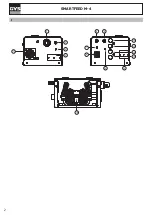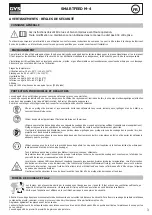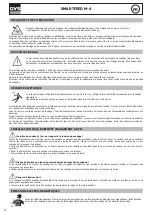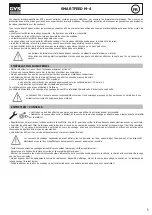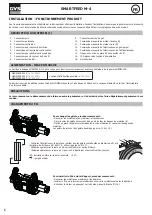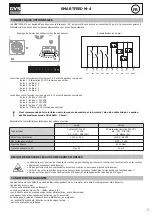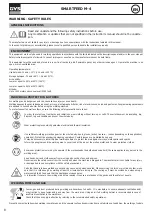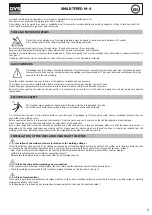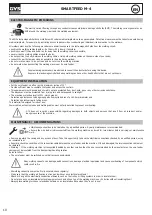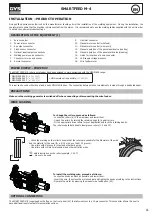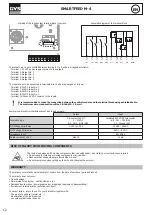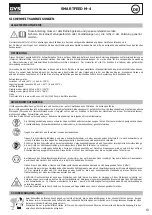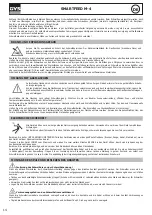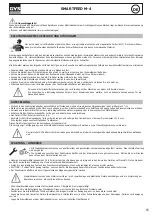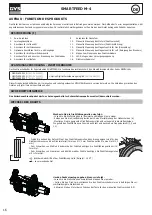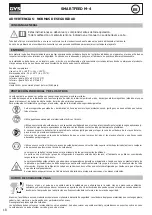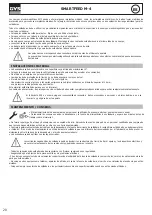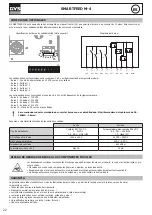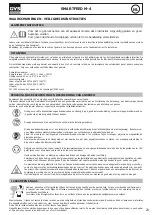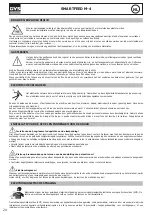
9
SMARTFEED M-4
EN
materials containing lead, cadmium, zinc, mercury or beryllium may be particularly harmful.
Also remove any grease on the metal pieces before welding.
Gas cylinders must be stored in an open or ventilated area. They must be stored vertically and held by a support or trolley to limit the risk of fall.
Do not weld in areas where grease or paint are stored.
FIRE AND EXPLOSION RISKS
Protect the entire welding area. Flammable materials must be moved to a minimum safe distance of 11 meters.
A fire extinguisher must be readily available near the welding operations.
Be careful of spatter and sparks, even through cracks. It can be the source of fire or explosion.
Keep people, flammable materials/objects and containers that are under pressure at a safe distance.
Welding in closed containers or pipes should be avoided and , if they are opened, they must be emptied of any flammable or explosive material (oil,
fuel, gas ...).
Grinding operations should not be carried out close to the power supply or any flammable materials.
GAS CYLINDERS
Gas leaking from the cylinders can lead to suffocation if present in high concentration around the work area (ventilation required).
Transport must be done safely: cylinders closed and welding machine switched off. They must be stored vertically and held by a
support to limit the risk of falling.
Close the cylinder between two uses. Beware of temperature variations and sun exposure.
The cylinder must not be in contact with a flame, electric arc, torch, earth clamp or all other sources of heat.
Always keep gas cylinders away from electrical circuits, and therefore never weld a cylinder under pressure.
Be careful when opening the valve on the gas bottle, it is necessary to remove the tip of the valve and make sure the gas meets your welding
requirements.
ELECTRICAL SAFETY
The electrical mains used must have an earth terminal. Use the recommended fuse size.
An electric shock could cause serious injuries or potentially even deadly accidents.
Do not touch any live part of the machine (inside or outside) when it is plugged in (Torches, earth cable, cables, electrodes) because they are
connected to the welding circuit.
Before opening the device, it is imperative to disconnect it from the mains and wait 2 minutes, so that all the capacitors are discharged.
Do not touch the torch or electrode holder and the earth clamp at the same time.
Ensure that cables and torches are replaced by qualified and authorized persons if they are damaged. Make sure that the cable cross section is
adequate with the usage (extensions and welding cables). Always wear dry clothes which are in good condition in order to be isolated from the
welding circuit. Wear insulating shoes, regardless of the workplace/environment in which you work in.
INSTALLATION OF THE REEL AND LOADING OF THE WIRE
Isolation of the welder at the arc in relation to the welding voltage !
Not all the different parts involved in the welding current can be protected against direct human contact. The welder must therefore avoid the risks
by following the relevant safety regulations. Even a contact at low current may take the operator by surprise and cause an incident.
- Wear dry and intact protective equipment (shoes with rubber soles/baked welder’s protective gloves without rivets or staples)!
- Avoid direct contact with non-insulated or connecting sockets!
- Always place the welding torch or electrode holder on an insulated support!
Risk of burning at the welding power connection!
If the connectors are not safely locked in place, the connectors and the cables can become hot and cause burns !
• Check the welding connectors daily and lock them in place if needed by turning them to the right.
Risk of electrocution !
If the weld is performed using different processes while the torch and the electrode holder are connected to material, a no-load voltage or welding
voltage is applied to the circuits !
At the beginning of a job and during interruptions, always isolate the torch and the electrode holder !


